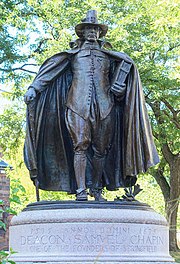
Back تطهيرية Arabic بيوريتانيه ARZ Puritanismu AST Puritanlar Azerbaijani Пурытанства Byelorussian Пурытанства BE-X-OLD Пуританство Bulgarian Puritanegezh Breton Puritanisme Catalan Puritáni Czech
| Part of a series on |
| Puritans |
|---|
 |
The Puritans were English Protestants in the 16th and 17th centuries who sought to rid the Church of England of what they considered to be Roman Catholic practices, maintaining that the Church of England had not been fully reformed and should become more Protestant.[1] Puritanism played a significant role in English and early American history, especially during the Protectorate.
Puritans were dissatisfied with the limited extent of the English Reformation and with the Church of England's toleration of certain practices associated with the Roman Catholic Church. They formed and identified with various religious groups advocating greater purity of worship and doctrine, as well as personal and corporate piety. Puritans adopted a covenant theology, and in that sense they were Calvinists (as were many of their earlier opponents). In church polity, Puritans were divided between supporters of episcopal, presbyterian, and congregational polities. Some believed a uniform reform of the established church was called for to create a godly nation, while others advocated separation from, or the end of, any established state church entirely in favour of autonomous gathered churches, called-out from the world. These Separatist and Independents became more prominent in the 1640s, when the supporters of a presbyterian polity in the Westminster Assembly were unable to forge a new English national church.
By the late 1630s, Puritans were in alliance with the growing commercial world, with the parliamentary opposition to the royal prerogative, and with the Scottish Presbyterians with whom they had much in common. Consequently, they became a major political force in England and came to power as a result of the First English Civil War (1642–1646).
Almost all Puritan clergy left the Church of England after the restoration of the monarchy in 1660 and the 1662 Uniformity Act. Many continued to practice their faith in nonconformist denominations, especially in Congregationalist and Presbyterian churches.[2] The nature of the Puritan movement in England changed radically. In New England, it retained its character for a longer period.
Puritanism was never a formally defined religious division within Protestantism, and the term Puritan itself was rarely used after the turn of the 18th century. Some Puritan ideals, including the formal rejection of Roman Catholicism, were incorporated into the doctrines of the Church of England; others were absorbed into the many Protestant denominations that emerged in the late 17th and early 18th centuries in North America and Britain. The Congregational churches, widely considered to be a part of the Reformed tradition, are descended from the Puritans.[3][4] Moreover, Puritan beliefs are enshrined in the Savoy Declaration, the confession of faith held by the Congregationalist churches.[5]
- ^ Spraggon 2003, p. 98.
- ^ Cliffe 2002, p. 195.
- ^ Miller 2008, p. 296: "Congregationalists were theologically descended directly from the Puritans of England and consequently enjoyed pride of place as one of the oldest, most numerous, and most significant religious groups in the colonies."
- ^ Morris, John W. (2011). The Historic Church: An Orthodox View of Christian History. Author House. p. 438.
- ^ Bremer & Webster 2006.
© MMXXIII Rich X Search. We shall prevail. All rights reserved. Rich X Search